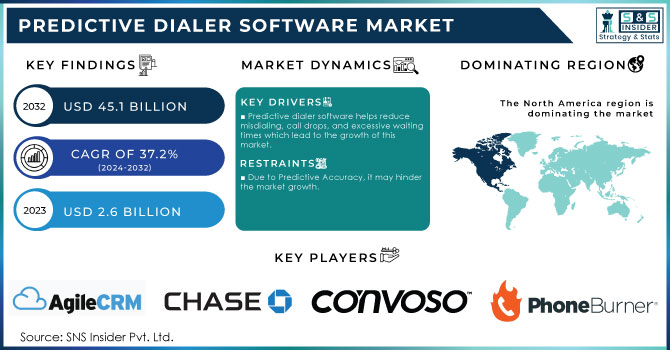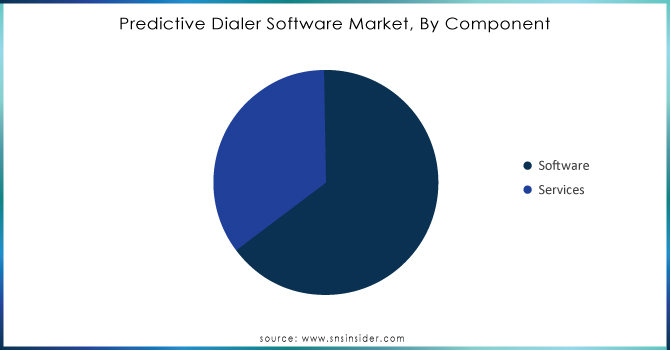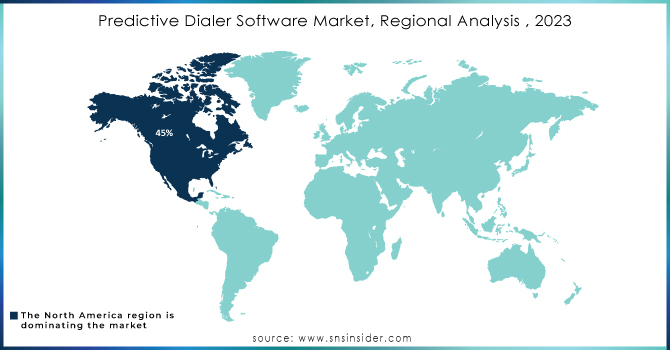Predictive Dialer Software Market Report Scope & Overview:
The Predictive Dialer Software Market Size was valued at USD 2.6 Billion in 2023. It is expected to grow to USD 45.1 Billion by 2032 and grow at a CAGR of 37.2% over the forecast period of 2024-2032.
The predictive dialer software market is going to grow as a result of consumers' rising preference for telemarketing as a way to communicate with businesses in real time and increase customer satisfaction. A common automated dialing technology used in contact centers is predictive dialer software, which makes outbound calls in sequence from a list of phone numbers. The program may be able to identify busy signals, disconnected numbers, voicemails, and unanswered numbers. It will then connect just those calls to the available contact center employee. By doing away with manual dialing, the predictive dialer software connects contact center personnel to calls only after they have been answered.

Get More Information on Predictive Dialer Software Market - Request Sample Report
The Federal Communications Commission (FCC) found that over 60% of consumers prefer businesses that offer real-time communication options, such as telemarketing, to enhance customer service experiences.
According to the U.S. Small Business Administration (SBA), contact centers that adopted automated dialing solutions, like predictive dialers, reported a 20-30% increase in productivity and a corresponding rise in customer satisfaction scores due to reduced wait times and better call handling.
The demand for mobile solutions is increasing, and vendors are offering predictive dialer software that can be used on mobile devices. This trend is expected to continue as more businesses adopt mobile-first strategies. Predictive dialer software is being used to collect and analyze data to gain insights into customer behavior and preferences. This data can be used to improve customer engagement strategies and drive business growth. The potential of power dialers to greatly increase agent productivity is one of their main advantages.
In fact, using a power dialer instead of the more conventional techniques of searching the database and manually dialing numbers will make agents almost 60% more productive. Higher contact rates, greater customer happiness, and improved sales outcomes for firms can all arise from this boost in efficiency.
Predictive Dialer Software Market Dynamics
Drivers
-
Potential to increase outbound calls drive the market growth.
-
Predictive dialer software helps reduce misdialing, call drops, and excessive waiting times which lead to the growth of this market.
The first and foremost feature of predictive dialer software that allows dialers to perform more efficiently is the reduction of misdialing. This feature works by solving the main problem with automatically generated calls when agents have to find the number, memorize it, and dial with their own hands. All these actions increase the chances of misdialing because the task’s monotony reduces attention, and misdials require more time to call the correct number. Predictive dialer software significantly reduces time by automatically dialing a call and transmitting it to agents when there is an answer. Besides, these systems take care of evenly distributing the number of calls to the agents, which reduces the risk of long waiting and misdialing.
The benefits of the feature are improved performance and effectiveness of the call teams. However, the second feature, rejection of hopeless calls, allows the customers to receive fewer dropped calls. The feature also affects agents’ proficiency but in a negative way due to increasing the risk of earlier dropped calls. The need for effective communication and loyal customers leads to the further expansion of the predictive dialer software market.
According to the Federal Communications Commission (FCC), predictive dialing technology can improve agent productivity by up to 300%, as it efficiently manages call connections and reduces the time agents spend on misdialed or dropped calls. This statistic underscores the effectiveness of predictive dialer software in enhancing operational efficiency and customer interactions, further contributing to the growth of the market.
Restraint
-
Due to Predictive Accuracy, it may hinder the market growth.
One of the restraints is the dependency of the software on the accuracy of predictions, while predictive dialer software is used for a variety of purposes and produces a range of benefits, the ability of the system to route and manage outgoing calls relies on the methods of prediction used by this software. However, as many scholarly studies and industry reports find, the quality of predictions performed by different types of systems cannot be guaranteed. For example, the quality of the data used to make predictions may not be of good quality because it is outdated or inaccurate, which results in a waste of calls when calls are routed to the wrong customers. Moreover, because customer preferences and behaviors change over time, maintaining the predictions in the systems can also be a challenge. This way, the inaccuracy of predictions affects productivity and efficiency, not to mention that poor predictions increase the considerable frustration experienced by agents and customers. Finally, the inaccuracies made by agents also harm the relationships between parties. Because poor predictions occasionally bring results that hurt sales and customer satisfaction, firms will also be discouraged from investing in such technologies. Thus, as a restraint, the inaccuracy in predictions limits the potential of the predictive dialer market.
Opportunity
-
Increasing adoption by small and medium-sized businesses Creates Opportunity.
-
Cloud-based solutions offer cost-effectiveness, scalability, and flexibility, which can benefit businesses of all sizes.
Predictive Dialer Software Market Segmentation Overview
By Component
The software segment held the largest market share of over 65% as of 2023. The software segment has become the primary driver of the predictive dialer software market, as businesses have come to rely on diverse functionalities to improve their operational processes and customer reach. An array of such applications, including automated dialing, on-call analytics, and monitoring, allow for a more efficient process of outbound calling. As companies endeavor to adjust their communication strategies, they come to rely on increasingly sophisticated software solutions. In addition to their inherent advantages, recent prediction dialer software also can implement artificial intelligence and machine learning, thus enabling a more accurate approximation in regard to busy periods for call recipients.

Do You Need any Customization Research on Predictive Dialer Software Market - Enquire Now
By Deployment
The cloud segment held the largest market share around 40% in 2023. Deployment of predictive dialer systems through cloud-based solutions does not imply the necessity of considerable investment in the hardware and infrastructure development on the part of the organization. This fact appears to be an increasingly beneficial solution for small and medium-sized enterprises that might not possess the resources or experience to set up the on-premise solutions themselves. Additionally, the deployment of a cloud-based system allows the agents to maintain their accessibility and work from home, call centers, or any location of their choice.
By End-Use
IT & Telecom segment held the largest market share around 32% in 2023. IT and Telecom industry is the major holder of the Predictive Dialer Software Market due to the need of efficient communication and customer engagement strategies. Outbound calling is the basic operation that many companies concentrate on to get in touch with clients, provide technical support, and introduce new services. Predictive dialers are highly efficient in these aspects as they reduce the calling time and automate the overall process. In addition, the IT and Telecom industry usually has many calls to manage which is why the effect of predictive dialing is more pronounced. This software is also usually integrated with advanced analytics and equipped with real-time data insights that telecom companies use to adjust their strategies in larger detail.
Predictive Dialer Software Market Regional Analysis
North America held the largest market share around 45% in 2023. Some of the major market players are based in North America. Predictive dialer system popularity in North America is also being fuelled by the enormous number of contacts centers operating there. These solutions are being aggressively adopted by contact centers in the area in order to improve operational efficiency, information delivery effectiveness, and internal process execution. Predictive dialer software has seen tremendous growth in North America, particularly in the United States and Canada. Predictive dialers have been widely adopted to increase agent productivity and customer engagement in the region's developed telemarketing, contact center, and customer service sectors. Predictive dialers are increasingly being used for market research, lead generation, and customer assistance in addition to more conventional applications. For vendors doing business in this area, adherence to legal regulations such as the Telephone Consumer Protection Act (TCPA) in the U.S. has been crucial.
The Asia Pacific market is anticipated to show the fastest growth. Over the course of the projection period. the regional market is anticipated to increase as a result of the increasing adoption of predictive dialer systems by both major and small and medium-sized businesses. It is projected that cost-effective and cloud-based systems will be used widely. the growth of the BPO sector, and rising customer service expectations. Predictive dialers are becoming increasingly popular as a result of the rise of countries like Malaysia, the Philippines, and India as major players in the contact center industry. Additionally, there is more interest in adopting predictive dialers for sales and customer service as a result of the expansion of e-commerce and online enterprises in nations like China. The focus on delivering better customer experiences and optimizing call center operations has contributed to the adoption of predictive dialers in select countries within this region.

Key Players in Predictive Dialer Software Market
-
Agile CRM (Agile Dialer)
-
Chase Data Corporation (Chase Dialer)
-
Convoso (Convoso Predictive Dialer)
-
NICE inContact (NICE CXone)
-
Phone Burner (PhoneBurner)
-
RingCentral, Inc. (RingCentral Contact Center)
-
Star2Billing S.L. (Star2Billing Predictive Dialer)
-
VanillaSoft (VanillaSoft Dialer)
-
Ytel Inc. (Ytel Predictive Dialer)
-
Five9, Inc. (Five9 Predictive Dialer)
-
Genesys (Genesys Cloud)
-
Aspect Software (Aspect Unified IP)
-
Dialpad (Dialpad Talk)
-
CallFire (CallFire Predictive Dialer)
-
Nextiva (Nextiva Call Center)
-
Zoho (Zoho CRM with Zia)
-
Talkdesk (Talkdesk Cloud Contact Center)
-
RingCentral Engage (RingCentral Engage Voice)
-
Zendesk (Zendesk Talk)
-
Freshcaller (Freshcaller Predictive Dialer)
Key User
-
Teleperformance
-
MarketPro
-
Zendesk
-
American Express
-
CVS Health
-
State Farm
-
Keller Williams Realty
-
University of Phoenix
-
Amazon
-
Democratic National Committee
Recent Development:
-
In February 2023, Five9 announced that it had partnered with Google Cloud to offer its predictive dialer software on Google Cloud Platform. This partnership gives businesses the ability to use Five9's predictive dialer software on Google's reliable and scalable infrastructure.
-
In March 2023, NICE inContact announced that it had acquired InVision, a provider of cloud-based customer experiences solutions. The acquisition of InVision gives NICE inContact a broader portfolio of products and services that can help businesses improve their CX.
| Report Attributes | Details |
| Market Size in 2023 | US$ 2.6 Billion |
| Market Size by 2032 | US$ 45.1 Billion |
| CAGR | CAGR of 37.2% From 2024 to 2032 |
| Base Year | 2023 |
| Forecast Period | 2024-2032 |
| Historical Data | 2020-2022 |
| Report Scope & Coverage | Market Size, Segments Analysis, Competitive Landscape, Regional Analysis, DROC & SWOT Analysis, Forecast Outlook |
| Key Segments | • By Component (Software, Services) • By Organization Size (Large Enterprises, Small & Medium Enterprises) • By Deployment (Cloud, On-premise) • By End Use (BFSI, Government, Healthcare, IT, Telecom, Others) |
| Regional Analysis/Coverage | North America (US, Canada, Mexico), Europe (Eastern Europe [Poland, Romania, Hungary, Turkey, Rest of Eastern Europe] Western Europe] Germany, France, UK, Italy, Spain, Netherlands, Switzerland, Austria, Rest of Western Europe]). Asia Pacific (China, India, Japan, South Korea, Vietnam, Singapore, Australia, Rest of Asia Pacific), Middle East & Africa (Middle East [UAE, Egypt, Saudi Arabia, Qatar, Rest of Middle East], Africa [Nigeria, South Africa, Rest of Africa], Latin America (Brazil, Argentina, Colombia Rest of Latin America) |
| Company Profiles | Agile CRM, Chase Data Corporation, Convoso, NICE inContact, Phone Burner, RingCentral, Inc., Star2Billing S.L., VanillaSoft, Ytel Inc. Five9, Inc. |
| Key Drivers | • Potential to increase outbound calls drive the market growth. • Predictive dialer software help reduce misdialing, call drops, and excessive waiting times which lead to growth of this market. |
| Market Restraints | • Due to Predictive Accuracy it may hinder the market growth. |

